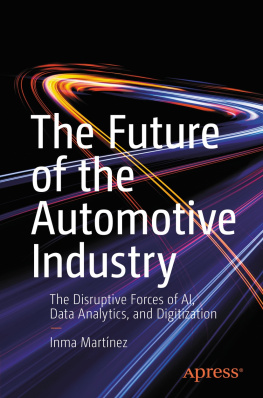
Contents
Landmarks
Figures
Tables
Page List
Future Tech
Contents
LIST OF FIGURES
LIST OF TABLES
In the introduction, I chart the concept of change through a historical lens, tracing it back to the major thinkers on the industrial revolution, Marx, Weber, and Durkheim. I then turn to technological waves in a historical context, tracing them all the way to our contemporary technologies and concerns and through to coronavirus and what might come next. That becomes the backdrop for a quick tour of the structure of the book, which has two parts. The first part is dedicated to a macro perspective on technology. The second part is designed to help you, as an individual, respond to technological change, both as an individual and in the groups you find yourself in (at work, in social movements, in your social life, or in your family).
Change is a misunderstood concept. When weather, seasons, emotions, or people change, all of us are driven to oversimplify. We look for a single cause, even though we know that change is typically caused by a myriad of factors. Why? Because simplifying things helps us cope. Our psychological reaction precedes an intellectual explanation.
Technological change is particularly complicated. Historically, we tend to overvalue technologys role in change. That phenomenon even has a nametechnological determinism. Even though this is a book called Future Tech, I will try not to fall victim to that determinism. Instead, I will go behind the technologies and look at what created them and what sustains them. Subsequently, I will get in front of them and chart what lies ahead, based on other equally salient disruptive forces, such as influences from government, business, society, or even the physical environment that surrounds us, Earths ecosystem.
The future of technology is, of course, not an exact science. I share the fate of many futurists who have, wisely, stepped back a bit from prophecies. Instead, we chart scenarios. We model likely developments based on the forces of disruption we see in play already today. That can be done only by having a clear idea of how contemporary society is put together, a necessarily incomplete and simplified model of how things generally tend to work, which in turn requires an awareness of history.
To start with, let me just note that social change is usually equally important in terms of shaping technology as technology is in shaping social change. To prove that point, it is tempting to quickly begin to summarize the lessons of the 2020 coronavirus pandemic. That event indeed has set the context for an enormous amount of changeand it came from the environment (an animal carried the virus), to society (manifesting itself first in China, then in Italy, then across Europe, and in Iran, spreading to the United States, and then to Brazil), and only subsequently influencing sci-tech (stimulating a massive vaccine effort among all the worlds top life science labs combined).
However, an even better perspective is gained from looking a bit further back in history. I would like to bring your attention to the industrial revolution. The reason I do that is that even though we call it an industrial revolution, the emphasis is often on technology when, in fact, it was social upheaval in cities that created the incentive and opportunity for such massive changes to take hold.
The industrial revolution of the 18th century caused migrations, upheaval, and economic progress, and created new winners and losers, individually and collectively. German thinkers Karl Marx and Max Weber, and French sociologist Emile Durkheim, and others, each attempted to explain this changeMarx and Weber found the driving forces to be at the individual level, Durkheim found them mostly to be at the collective level. Both ways of looking at it can be fruitful.
Marxs observations on change
Marxs (1990) explanation, largely based on UK data, focused on how individuals respond to the class struggle. He held that class struggle (within the capitalist system) was inherent to the new industrial production of goods. A workers identity was tied to the goods that were produced. To realize their true selves, workers had to rise above their status as servants to the technology to become owners of the instruments of production.
In other words, technological progress had to go hand in hand with changes in the ownership of the instruments of production. In Marxs mind, progress stems from the conflicts that necessarily arise out of people exercising their true interests. Marxs writings are commonly misunderstood as calls to action instead of explanations of the process of social and technical change, yet they were both. Any true revolutionary has a deep understanding of the society they are trying to change. Anything else would be unethical and short-sighted.
Webers observations on change
Webers (1922) explanation of change centered on the specific role of the Calvinist interpretation of the protestant work ethic in fueling capitalism as the answer to whether people should expect to be saved. Calvinists first broke from the Roman Catholic Church in the 16th century. Weber maintained that a complex set of rationales could help people attain meaning through the external evidence they saw from their efforts. As a result, hard work, discipline, and frugality became traits that, over time, produced tremendous change in the living conditions for workers as well as, in turn, for society. Webers analysis, which appeared in 190405, was based on studying a particular Swiss-German version of Protestantism around the turn of the century, and in a historical perspective and context. Calvinism is arguably a major denomination still thriving today, although todays adherents, at least in the US, have abandoned many key Calvinist tenets and many Puritan ministers also have adapted the message slightlyalthough the work ethic certainly made it to the new world, and to America in particular. Today, however, it would be fair to say that hard work is motivated by the secular version of the American dream as much as by a religious motivation.
But Weber, in his foresight, had thought of that. He was also worried that rationalization would lead society astray. He worried about the inescapable iron cage of bureaucracy gone amok. Many have worried about bureaucracy and clearly there are governments that attempt to control individuals to an unnecessary degree.
What Weber pointed out was how the interplay of class, status, and party contributes to the distribution of power in a community. With that came the gradual understanding that economic value is complex and cannot just be derived from simply looking at the material conditions that created it. Weber, in fact, built the foundation for the understanding of social value, a much more complicated thing, and immensely much more valuable than pure economic gain. Technology, in this picture, is not an economic causality, it is much more complex, and is tied to social value and, in Webers eyes, to the specific culture of the metropolis (Weber, 2005).
Durkheims observations on change
Durkheim, on his side, focused on the role of the collective in bringing people together in new ways (enabling solidarity), such as in larger cities. To him, the collective was a more natural state (than simply being an individual) in which people were bonded by their affinities, to their families, friends, tribes, and co-workers. The collective represented a social consciousness that prioritized harmony over discord. Alienation, or suicide, was explained by the breakdown of the bonds of the collective, a function of the way society worked, and not the result of individual action and thus subject to rationality or motivation, as such.
Next page










